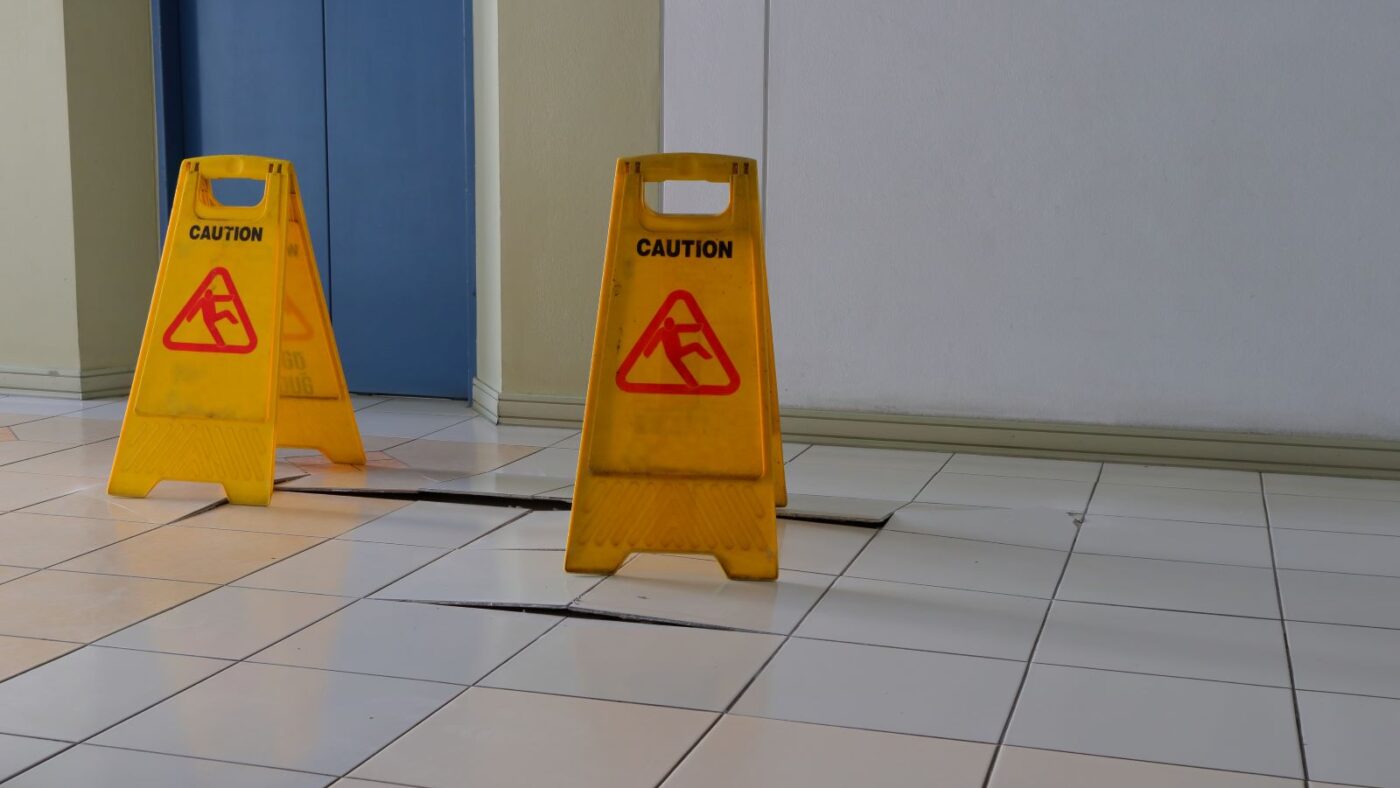Often viewed as a simple collateral item, tile flooring has its complexity and wide effect on claims. If you notice tile flooring issues, it is best to have them reviewed at the start of investigations.
The Importance of Flooring Tile Issues
Tile is a common flooring finish material that, when installed properly and maintained as needed, is a reliable part of the building. Tile flooring is right under our feet and usually reliable which makes us often take it for granted.
In this article, we will discuss some of the common installation issues associated with tile, and how to recognize issues when they begin to manifest.
Types of Tile Flooring Problems
There are two common major issues we encounter when investigating a tile floor.
Nonbonding – Tiles lacking full secure adhesion to the substrate. Lack of adhesion can be complete or partial to either an individual tile or across the tile floor. Tile flooring stays within the same approximate plane of original installation. Note that just because a tile is found to be nonbonded does not automatically mean that it has become so due to “debonding”. The tiles may have never been installed bonded sufficiently during the original installation.
Buckling – Differential out-of-plane movement of tile flooring resulting in a noticeably tented or lifted dislocation and separation in appearance. This condition will exhibit itself in a dramatic fashion, visually and/or as a tripping hazard. Usually accompanied by nonbonded tile at the tented/lifted area along with very noticeable cracking due to the out-of-plane deformation of brittle tile and grout.
Inspection for Nonbonding and Buckling
Occurrence of these issues are determined by:
Nonbonding – Usually not directly observable; determined by tapping (“sounding”) the top of tiles and listening for a dull (“hollow”) sound. Limits of hollow sounding tile flooring can be drawn on a sketch with a layout of rooms to show its extent. Typically, this layout should also capture information regarding other flooring characteristics, the perimeter configuration, other peripheral items of note, and proximity to sources of moisture and temperature differentials. Layout sketch should also capture other instances of dislocation and/or displacement of the tile flooring other than just nonbonding. These other instances will include locations of buckled tiles that need to be indicated and located in relation to layout.
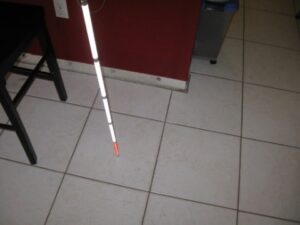
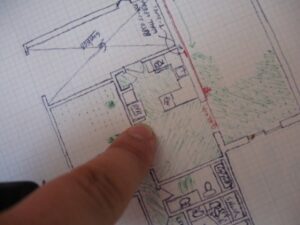
Buckling – Uplifted (“tented”) flooring tiles exhibited by a change in slope and/or dislocation within the flooring itself. The dislocation can be pronounced enough to yield a separation in flooring to expose a gap beneath the uplifted portion. The location and limits of this buckled flooring need to be documented within sketches to show the proximity and configuration in relation to other noted surroundings.
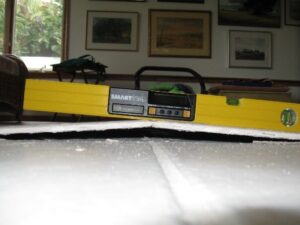
General Causes of Nonbonding and Buckling
Tile is often installed using a thin-set application of modified or unmodified Portland cement-based mortar material. In the “thin-set” installation method the thin-set material is applied to the substrate using a notched (grooved) trowel within which the tiles are set into.
Nonbonded tiles can be due to simply not having been adequately bonded or completely nonbonded since installation. Provided the tiles were originally properly bonded to the substrate, then the cause of resultant debonding (and more dramatic – buckling) is usually from the accumulation of forces in-plane at interfaces of diverse materials. Differential expansion and/or contraction of materials causes forces to gather at interfaces. This can cause forces to assemble that exceed the shearing strength of adhering bonds between the bottom of the tile and substrate. Tiles could have been installed in an incomplete fashion that has since debonded and buckled at an inadequate setting from the substrate. In addition, tiles could have been installed in a defective manner where forces due to said defect have caused debonding.
Additionally, more specific causes can include:
- Tiles grouted tight to perimeter abutting items
- Tile flooring extent exceeds intervals requiring expansion joints per installation standards
- Top of slab substrate being too smooth with a near-polished (e.g., like glass) finish
- Top of slab encapsulated with a curing compound serving as a bond breaker
- Paint overspray or other top-of-slab surface contaminant serving as a bond breaker
- Insufficient thickness of thin-set material
- Inadequate thin-set coverage area proportion between backside of tile and substrate
- Improper bonding attempt of thin-set that has already setup (cured) before placement
- Grout width is insufficient for tile type, where ceramic needs wide grout widths compared to porcelain that are narrow
- Tiles, thin-set, grout and/or substrate are incompatible with installed environment
- Improperly mixed thin-set material
- Thin-set product placed had been allowed to remain unused to age beyond expiration date in storage
- Cyclic/repeated wetting & drying from exposure to water from point sources or capillary action
- Accumulated moisture from vapor drive through slab or flooring assembly
Visual Indicators of Nonbonding or Buckling
Some evidence of common causes of nonbonding or buckling are depicted in the field as follows:
Tight Perimeter Abutment – Usually indicated by tiles being grouted tight up to and against perimeter baseboards, door cases, and/or similar surrounding restraining items. A gap between tile flooring and perimeter abutting items should always be present. This gap can be open, obscured from view (covered) with finish trim, or filled with a pliable elastomeric material. This gap should not be filled with a rigid non-yielding substance such as concrete, mortar/cementitious grout, or allowed continuance of tile outward to push against affixed perimeter abutting items.
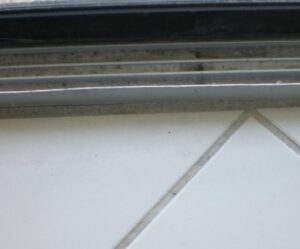
Smooth Top of Slab Surface – Normally indicated by a very smooth top surface of slab that is not rough enough or scarified to accept the adequate bonding of thin-set. Thin-set will usually be found remaining adhered to bottom of tile and sheared away from top of slab, where the top of slab can often left very clean and viewed with little/no thin-set remaining adhered to the top surface.
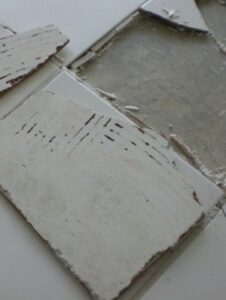
Curing-Compound Bond-Breaker – Slab surface can exhibit some roughness while being clean of thin-set that remains attached to the bottom of tile. However, upon placing a small droplet of water on the exposed top of the slab, the droplet will remain beaded and will not soak into concrete for minutes. This indicates that curing compound was used on top of slab which is a bond breaker.
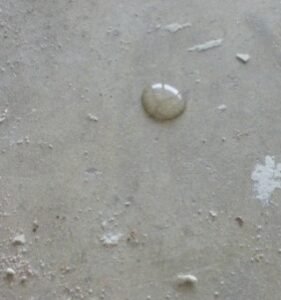
Paint-Overspray Bond-Breaker – The top of the slab will exhibit a paint coating that spans across its topside surface. This is often the result of finishes that were spray-painted laying on top of slab where the paint coating from overspray remains on top of the slab surface. Paint coating will create a bond-breaker condition similar to that as curing compound coating previously discussed. This will usually leave a clean slab surface with thin-set remaining on the back of tile.
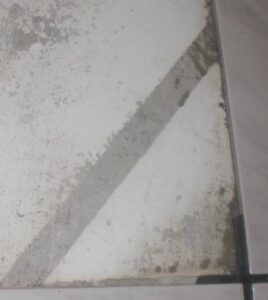
Inadequately Cured Thin-Set – Hardened thin-set will be displayed in rows due to comb pattern from edges of trowel. Because thin-set had mostly cured, when the tile was pressed from above the waffle pattern on the back of tile made only light depressions across the top of the hardened comb pattern. Note that thin-set is intact and remains bonded to the top of slab. If bonded properly the thin-set remnants would have been shared between top of slab and back of tile.
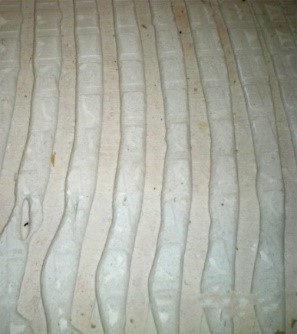
How to Stop the Damage & Repair
Once nonbonding and/or buckling manifest themselves, practical repair is unlikely. Due to temperature changes, it will be nearly impossible to stop the spread of nonbonding and/or buckling damage. The probable solution is to remove the affected tile up to a joint or stair/step transition and replace. Replacement tile should use adequate methods prescribed in the installation manuals authored by the Tile Council of North America (TCNA) and the American National Standards Institute (ANSI). While epoxy injection can be used, it will have very limited success (if any) that cannot be guaranteed.
To learn more about VERTEX’s Forensic Engineering services or to speak with an Engineering Expert, call 888.298.5162 or submit an inquiry.



